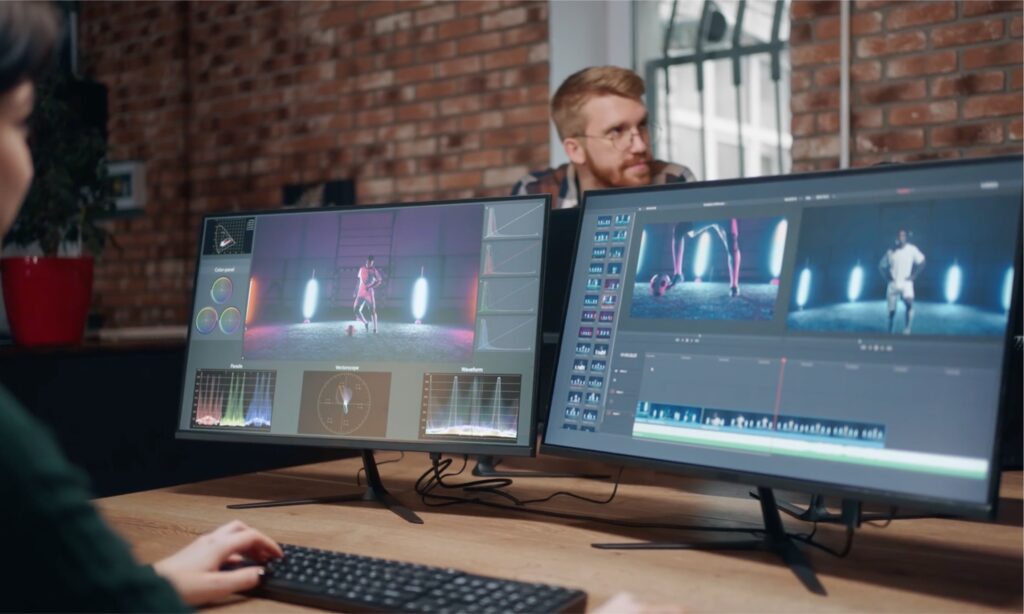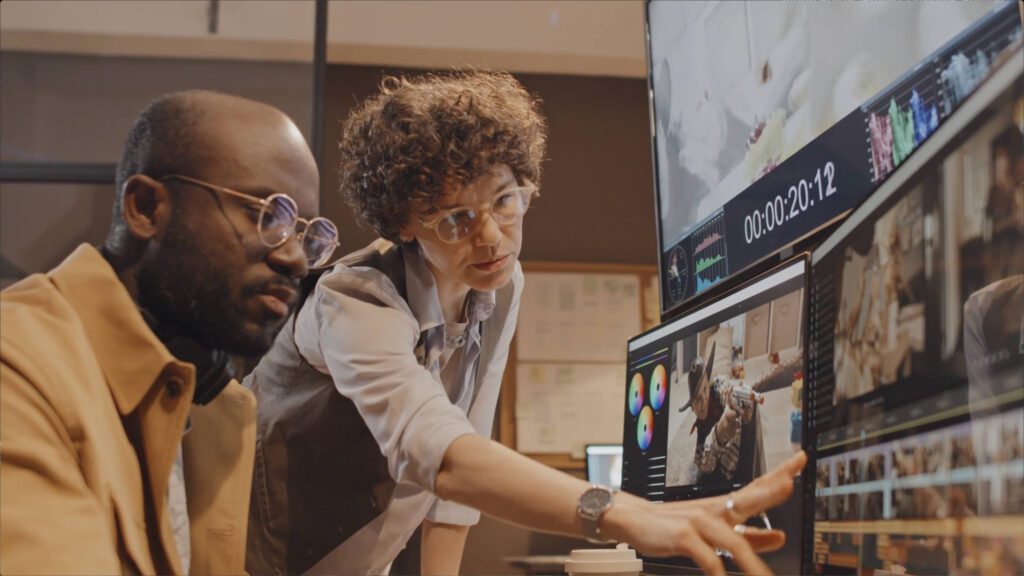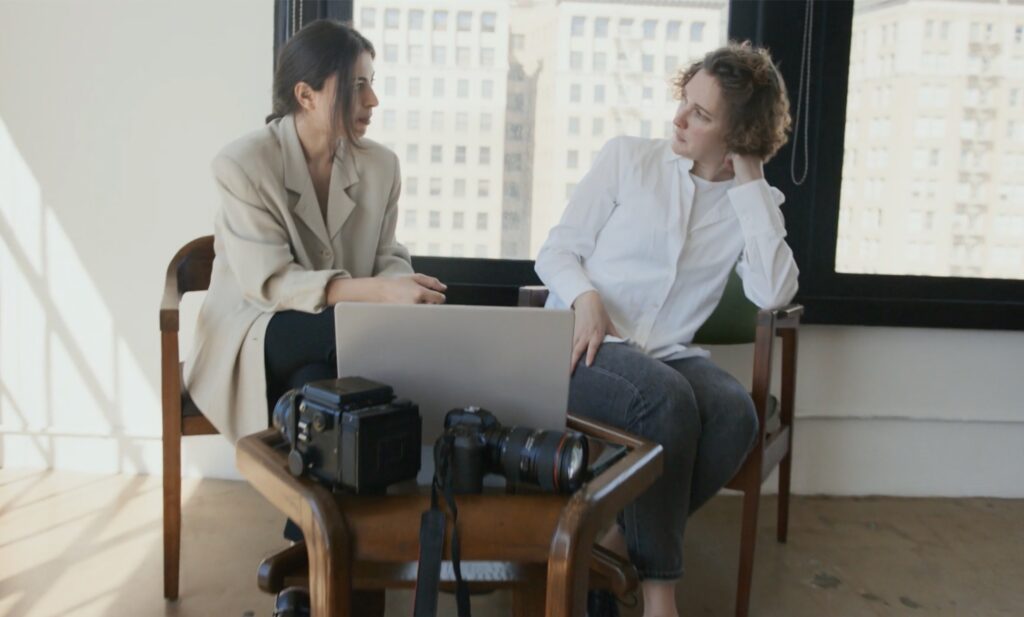B-roll, often termed supplementary footage, plays a pivotal role in video production and storytelling. Distinct from the primary A-roll, B-roll functions as secondary footage, bolstering and enriching the narrative. Its effectiveness lies in providing editors with additional options and facilitating seamless transitions during the editing process. In essence, B-roll serves as a vital storytelling tool, enhancing the overall impact of the video. The question arises, “What is B roll in video?” — a query central to understanding its significance in the production process.
B-roll plays a crucial role in adding context, engaging the audience, and elevating the overall viewing experience. It encompasses different types of shots, including establishing shots, cutaways, reenactments, and stock footage. Each type of B-roll serves a specific purpose and contributes to the visual storytelling of the video.
Understanding the importance of B-roll in video production is essential for video editors and filmmakers. Shooting compelling B-roll footage requires careful planning, finding visually interesting shots, and maintaining technical quality. By incorporating B-roll effectively, creators can enhance the narrative and create more immersive and engaging videos.
Key Takeaways:
- B-roll is supplementary footage that supports and enhances the narrative in video production.
- It provides options for editors during the editing process and creates seamless transitions.
- B-roll adds context, engages the audience, and enhances the overall viewing experience.
- Different types of B-roll include establishing shots, cutaways, reenactments, and stock footage.
- Shooting compelling B-roll requires careful planning, finding visually interesting shots, and maintaining technical quality.

The Importance of B-roll in Video Editing
B-roll is an essential element in video editing, providing editors with a range of options and opportunities to enhance the final product. It plays a crucial role in creating seamless transitions, masking cuts, and pacing the story. By incorporating B-roll footage effectively, editors can elevate the storytelling and improve the overall quality of the video.
One of the key advantages of B-roll is the flexibility it offers during the editing process. Editors can choose from a variety of supplementary shots to seamlessly transition between scenes or cover any cuts that may disrupt the flow of the narrative. This allows for a smoother viewing experience, ensuring that the audience remains engaged throughout.
B-roll also plays a significant role in pacing a story. By providing moments of visual respite or adding contextual information, it allows the viewer to process and absorb the content more effectively. This deliberate pacing helps build tension, highlight important details, and create a more dynamic and engaging video.
Incorporating B-roll into video editing is like adding layers to a painting, enhancing the depth and richness of the final composition.
The Importance of Seamless Transitions
Seamless transitions are a vital aspect of video editing as they contribute to the overall viewing experience. B-roll footage allows editors to conceal abrupt cuts and create a natural flow between shots. By choosing appropriate B-roll footage, editors can establish a connection between scenes, maintain the audience’s attention, and ensure a cohesive narrative.
| B-roll Techniques | Benefits |
|---|---|
| Matching Action | Smooth transitions, maintains continuity |
| Parallel Editing | Builds tension, adds visual interest |
| Cross Dissolves | Softens transitions, creates a dreamy effect |
By utilising these techniques and other creative approaches, editors can elevate their storytelling and create a more immersive and engaging video.
In conclusion, B-roll is an invaluable asset in video editing. It provides options for editors, facilitates seamless transitions, and helps pace the story. By understanding the importance of B-roll and utilising it effectively, video editors can create visually compelling content that captures the audience’s attention and enhances the narrative.
Different Types of B-roll and Their Uses
When it comes to creating compelling videos, utilising different types of B-roll footage can greatly enhance the visual storytelling and engage the audience. Each type of B-roll serves a specific purpose and contributes to the overall narrative. Let’s take a closer look at some of the most common types of B-roll and how they can be effectively used:
1. Establishing Shots
Establishing shots are wide-angle shots that provide context and set the scene for the video. These shots are typically used at the beginning of a scene or to transition between locations. They give the audience a sense of the environment and help them understand the overall setting of the story.
2. Cutaways
Cutaways, also known as inserts, are shots that are used to show additional information or reactions related to the main shot. They are often used to illustrate specific details, emphasise emotions, or provide visual interest. Cutaways help to break up the main footage and add depth to the storytelling.
3. Reenactments
Reenactments are recreations of events that are being discussed in interviews or voiceovers. They allow the audience to visually understand what is being described and bring the story to life. Reenactments can be particularly effective in documentaries, historical pieces, or storytelling videos.
4. Stock Footage
Stock footage refers to pre-existing footage that can be licensed and used in videos. It is a valuable resource when specific shots or resources are not available. Stock footage can be used to enhance the visual quality of a video, add variety, or illustrate concepts that may be difficult to capture otherwise.
By understanding the different types of B-roll and their uses, video creators can effectively incorporate them into their storytelling, making their videos more engaging and visually compelling.
| Type of B-roll | Uses |
|---|---|
| Establishing Shots | Provide context and set the scene |
| Cutaways | Show additional information or reactions |
| Reenactments | Recreate events being discussed |
| Stock Footage | Enhance visual quality and add variety |
How to Shoot Compelling B-roll Footage
Shooting B-roll footage is an essential aspect of video production that requires careful planning and attention to detail. To capture compelling shots that enhance the storytelling of your video, consider the following tips:
1. Plan Ahead
Before shooting, take the time to thoroughly understand the narrative of your video and identify the specific shots you need to support it. A well-planned shot list will help you stay organised and ensure you capture the necessary footage. Consider the locations, angles, and camera movements that will best showcase your subject matter.
2. Find Compelling Shots
Look for visually interesting and unique shots that add depth and intrigue to your video. Explore different perspectives and angles to create variety and capture the essence of the story you’re telling. Seek out captivating details, dynamic action, and emotionally resonant moments that will engage your audience.
3. Maintain Technical Quality
While focusing on capturing compelling footage, it’s important not to overlook the technical aspects of shooting. Pay attention to lighting, composition, focus, and audio quality to ensure your B-roll footage is visually and technically strong. Use proper exposure settings, stable camera movements, and clear audio recording techniques to maintain the overall technical quality of your video.
By following these tips, you can shoot compelling B-roll footage that enhances the visual storytelling of your video. Remember to plan ahead, find visually engaging shots, and maintain technical excellence throughout your shoot. With well-executed B-roll, you can elevate the quality of your video and create a more immersive and engaging viewing experience for your audience.
Conclusion
B-roll is a crucial component of video production, enhancing the narrative and elevating the overall visual storytelling. It provides depth, context, and visual interest to the main footage, making it more engaging for the audience. By understanding the importance of B-roll and knowing how to shoot and incorporate it effectively, video editors and filmmakers can create more immersive and captivating videos.
Throughout this article, we have explored the different types of B-roll, including establishing shots, cutaways, reenactments, and stock footage. Each type serves a unique purpose in adding depth and enhancing the storytelling. By utilising a variety of B-roll shots, creators can provide context, capture additional information, and engage the audience on a deeper level.
Shooting compelling B-roll footage requires careful planning, finding visually appealing shots, and maintaining technical quality. By capturing ample footage and coverage, video editors have more flexibility during the editing process, allowing them to create seamless transitions and pace the story effectively. This attention to detail and preparation result in enhanced visual storytelling.
In conclusion, B-roll in video production is an essential tool for enhancing the narrative and creating a more immersive experience for the audience. By utilising different types of B-roll shots and understanding how to shoot and incorporate them properly, video creators can elevate the quality and impact of their videos, making them more captivating and memorable.
FAQ
What is B-roll in video?
B-roll is supplementary footage or alternative shots used in a video, in contrast to the main footage known as A-roll. It plays an important role in storytelling and provides options for editors during the editing process.
Why is B-roll important in video editing?
B-roll is essential in video editing as it gives editors options when cutting a video and allows them to mask cuts that may disrupt the flow of the narrative. It creates seamless transitions between scenes or shots and helps pace the story.
What are the different types of B-roll and their uses?
The different types of B-roll include establishing shots, cutaways, reenactments, stock footage, and more. Establishing shots provide context, cutaways show additional information or reactions, reenactments recreate events, and stock footage can be used when specific footage is not available.
How can I shoot compelling B-roll footage?
Shooting compelling B-roll footage requires careful planning and preparation. It is important to have a clear understanding of the narrative and the shots needed to support it. Finding visually compelling shots and maintaining technical quality are key.
What is the importance of B-roll in video production?
B-roll adds depth, context, and visual interest to the main footage. It enhances storytelling, engages the audience, and elevates the overall video quality, making the viewing experience more enjoyable.





